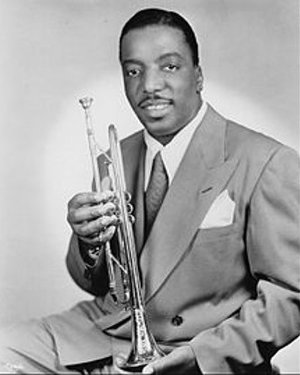Erskine Hawkins

-
Born
July 26, 1914
Birmingham, Alabama -
Died
November 1, 1992 (age 78)
Willingboro, New Jersey -
Featured Vocalists
Ida James
Nicknamed the “Twentieth Century Gabriel,” bandleader and composer Erskine Hawkins is best remembered today for the song “Tuxedo Junction,” which became a big hit for his own orchestra as well as those of Glenn Miller and Jan Savitt.
Hawkins, who lost his father in WWI, studied drums and trombone at an early age before deciding to take up trumpet at age 13. While attending Alabama State Teachers College, he became leader of a school band called the Bama State Collegians. The group recorded on the Vocalion label and made two trips to New York—the first in 1934 and the second in 1936. During the second trip, the Collegians appeared with Chick Webb’s orchestra at the Savoy Ballroom. They decided not to return to Alabama and soon changed ther name to the Erskine Hawkins Orchestra. Early vocalists were Billy Daniels in 1936 and Ruby Hill in 1937.
The band hits its stride in 1938 when it spent the summer at the Savoy, from where they were featured three times a week on NBC radio. They signed with Bluebird in August. That year, they also picked up long-time male vocalist Jimmie Mitchell, who remained with Hawkins through the rest of the band’s existence. Ida James, who became the orchestra’s most important singer, joined in late 1938. James stayed with the band until at least August 1942, when she left to go solo. Other vocalists include Merle Turner in 1938, Dolores Brown in 1939 and 1940, and Laura Washington in 1940.
Brown married Hawkins trumpet player Marcellus Green. The orchestra suffered a major setback in August 1942 when Green died in a car accident near Chattanooga, Tennessee. Pianist Avery Parrish, bassist Lee Stanfield, and saxophonist Heywood Henry were also seriously injured in the wreck. The band’s sound took a hit due to the loss of such key musicians, and many critics believe it never recovered.
After the recording ban of 1942 to 1944 ended, Hawkins signed with Victor. Asa “Ace” Harris had taken over piano by that time and also sang. Harris left the band in 1947 to lead his own combo but returned by 1950. Brown and Carol Tucker provided female vocals in 1945, with Ruth Christian singing in 1946 and Laura Washington returning that year, remaining into 1947. The orchestra signed with Coral in 1950 and recorded on the King label in 1952. The group’s later recordings began to take on a R&B flavor.
Hawkins disbanded in 1953, forming a quartet. He continued recording and performing up through the 1980s when bad health finally forced him to retire. Erskine Hawkins passed away in 1992 after suffering a heart attack.
Sources
- Simon, George T. The Big Bands. 4th ed. New York: Schirmer, 1981.
- “Orchestra Notes.” Billboard 16 Jan. 1937: 14.
- “Reviews of Acts and Bands: Erskine Hawkins and Orch.” Billboard 3 Apr. 1937: 19.
- “Orchestra Notes.” Billboard 23 Jul. 1938: 12.
- “Orchestra Notes.” Billboard 3 Sep. 1938: 12.
- “Orchestra Notes.” Billboard 15 Oct. 1938: 12.
- Matthews, Ralph. “Looking at the Stars.” Washington Afro-American 15 Apr. 1939: 10.
- “Vaudeville Reviews: Orpheum, Los Angeles.” Billboard 3 Jan. 1942: 25.
- “Vaudeville Reviews: Orpheum, Minneapolis.” Billboard 24 Jan. 1942: 22.
- “On the Air: Erskine Hawkins.” Billboard 28 Mar. 1942: 14.
- “Record Reviews: Erskine Hawkins.” Down Beat 1 Jul. 1942: 8.
- “Hawkins Please.” The Afro-American [Baltimore, MD] 18 Jul. 1942: 10.
- “Green, Hawkins Sideman Killed.” Down Beat 1 Sep. 1942: 1.
- “On the Records: Erskine Hawkins.” Billboard 8 Aug. 1942: 68.